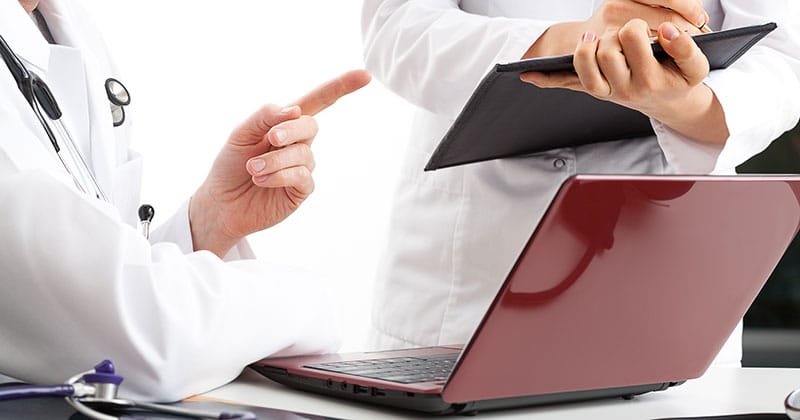The adoption of practice management systems has gained traction over the past few years. The global practice management software market is currently valued at USD $11.69 billion, and it’s expected to hit USD $17.92 billion by 2029.
Practice management software solutions are becoming increasingly popular because they streamline healthcare workflows, enhance patient care, and improve practice performance.
RELATED ARTICLE: 9 Benefits of a Medical Practice Management System
But let’s take a step back.
First, let’s define practice management software. What tasks does it manage? How does it help healthcare practices improve workflow?
This article is a comprehensive guide to the inner workings of practice management software. It covers everything you need to know, including:
- The definition of practice management software
- Practice management software vs. electronic health record (EHR) software
- Key features of the most effective PMS
- How PMS improves patient experiences and practice administration
These points will provide helpful insights into practice management software and how you might apply it within your practice.
The Differences Between EHR and Practice Management Software
Before we discuss the differences between EHRs and PMS, you need a basic definition of practice management software. At its core, PMS is a digital management solution designed to smooth practice administration by reducing paperwork and automating certain aspects of everyday operations.
These are the primary tasks of practice management software:
- Simplifying appointment scheduling and organization
- Automating patient reminders
- Verifying patient insurance
- Claim scrubbing and claim management tasks
- Expediting claims submissions
- Creating patient responsibility estimates
- Billing patients and processing payments
- Analyzing data and generating informative reports
Practice management software is sometimes confused with electronic health record (EHR) software. Each has different capabilities and users. Providers are the primary users of EHR, and PMS largely serves administration staff.
For clarity’s sake, let’s review the differences between them.
An EHR is a digitally accessible record of a patient’s medical information containing patient data collected from professional medical/clinical work. EHRs supply current and complete information to providers and staff, such as:
- Patient medical history
- Diagnosis and prognosis
- Labs and imaging
- Current and past prescriptions, treatments, and procedures
- Patient health information from other providers
EHR software stores and organizes clinical data as it pertains to patients, whereas practice management software focuses on administrative functions.
The use cases for the two solutions are also different. Clinicians and other healthcare practitioners use EHR software, while PMS is primarily used by practice managers and administrators.
It’s easy to see how they both play essential roles in healthcare digitization, and providers should use both solutions in tandem to realize the full benefits of each.
FROM ONE OF OUR PARTNERS: Drive Revenue and Improve Patient Care With a Fully-Integrated EHR

Key Components of Effective Healthcare Practice Management Software
There are vast numbers of practice management solutions on the software market today. However, not all practice management software options are created equal. It’s critical to understand what tasks they should be able to execute before choosing your software.
Your PMS must include a full suite of features and capabilities to augment your practice’s daily operation. Here are the crucial attributes of any effective healthcare practice management software:
High-Level Security
When it comes to digital healthcare solutions, cyber-safety should always come first, for good reason. In 2023 alone, there were a record 809 data breach incidents in the U.S. healthcare industry.
Practice management software stores sensitive patient and staff data, making it a desirable target for theft. Cybercriminals usually go after personally identifiable information (PII), including patients’ names, banking details, passwords, and other personal details. They’ll go to great lengths to get it.
Good practice management software secures staff and patient data using advanced cybersecurity measures, including:
- Multi-factor authentication
- High-level encryption
- Firewalls
- Automated threat detection and mitigation
- Reliable data backup and disaster recovery
Also, PMS must comply with HIPAA and PCI DSS regulatory security standards and update regularly to ensure continued adherence to changes. Noncompliance can result in legal ramifications like heavy fines, professional sanctions, and possible imprisonment.
Functionality
Embedded functions within PMS should make operational aspects of a practice easier for everyone who uses it—patients, providers, and staff. You want a comprehensive practice management software with the following functional features:
- Patient portal
- Billing and invoicing
- Reporting and analytics
- Data security regulation compliance
- Cloud-based data storage
- EHR integration
- Integration with existing software solutions
Easy-to-Use Interface
The whole point of going digital is to streamline administrative tasks. A needlessly complicated PMS user interface defeats that purpose.
Your practice management software should be easy to learn and forgiving to new users, both on the administrative and the patient-facing sides. All user-facing functions should be clearly identifiable, and the navigation should be intuitive and responsive.
Mobile Compatibility
Portability is an essential feature of any modern digital solution. Staff, providers, and patients should be able to access and use the application from anywhere, including mobile devices.
Given the growing popularity of telehealth, a mobile-compatible practice management tool is a must. It bridges the gap between remote patients and healthcare providers.
Mobile compatibility isn’t a luxury anymore. It’s a necessity. Smartphones and devices are more accessible and convenient for most people, which explains why mobile devices are outpacing desktops in most cases.
Easy Customization and Scalability
Choose a practice management software that supports customization. The more flexible the software, the better.
While two healthcare practices may offer the same services, they may do so in extremely different ways. Every practice has unique digital preferences, and customizability allows providers to adapt the interface, security features, reporting style, and even aesthetics to suit their needs.
In short, the software should adapt to the practice, not vice versa.
The same is true regarding scaling with the practice as it grows. Software should be able to accommodate new users, patients, practitioners, and management requirements. If you must migrate to yet another software when you reach a certain user volume, it may not be the best solution for you.
FROM ONE OF OUR PARTNERS: How to Choose the Right Practice Management Platform

How Practice Management Software Can Improve the Patient Experience
Can practice management software truly improve patient experience? Yes, it definitely can.
Improving practice efficiency certainly impacts patient experience, but some patient-facing considerations contribute to a positive journey as well. The patient experience revolves around six factors:
- Professionalism
- High-quality health services
- Empathy
- Communication
- Patient satisfaction
- Convenience
Practice management software touches on all six patient experience factors in the following ways:
Simplifies the Patient’s Journey
Practice management software typically includes a patient portal that allows the patient to be a more active participant in their own healthcare journey.
The patient experience begins when scheduling an appointment. Patients can schedule, reschedule, and even cancel appointments through the patient portal without calling or visiting the clinic.
They can check in for their appointment in advance by completing patient questionnaires and intake forms. They can also provide their insurance information online.
Moreover, the system automatically handles insurance verification and copay amounts, so the patient knows their responsibility before arriving.
Then, once the appointment ends, the patient can view their bill and make payments using the same portal.
Practice management software minimizes friction and obstacles in the patient’s journey, creating a smoother process and overall happier patients.
Minimizes Delays
Nobody likes waiting. It’s especially frustrating for patients with urgent health concerns or those squeezing appointments into their busy schedules.
While delays are not always avoidable, an efficient PMS helps minimize them as much as possible. The software decreases, even eliminates, holdups like overscheduling and registration errors by simplifying scheduling and creating waiting lists. It also verifies patient eligibility automatically, reducing the amount of time spent on the phone with insurance companies.
Overall, staff spends less time on administrative tasks and more time creating a seamless patient experience.
RELATED ARTICLE: 5 Time-Saving Features Needed in a Practice Management System
Improves Accuracy
Patients can be understandably rigid regarding billing. Errors are a major source of frustration and, thereby, wasted time in the patient journey. They can damage patient-provider relationships and ultimately lead to lost revenue.
Practice management tools are designed to prevent billing mistakes and catch errors before they impact practice efficiency and patient experience.
PMS helps practices deliver accurate estimates of patient responsibility the first time. They enhance transparency in pricing and provide complete and correct statements so that patients can easily see the charges.
Provides a Means to Connect With Patients
Practice management software often incorporates patient communications tools that allow providers to connect with and engage patients in critical ways.
For instance, the software can automatically send patients appointment reminders with the option to reschedule directly from their device. Providers can even check in on patients as part of treatment follow-up.
Some PMS solutions may host a customer relationship management (CRM) system, which provides additional support for a wider range of patient-facing communications.
RELATED ARTICLE: Improve Patient Engagement and Office Productivity with a Single Unified Communications Platform

How Practice Management Software Enhances Practice Administration
In addition to improving patient experience, PMS boosts a practice’s administrative performance. Here are five ways that a practice management system enhances practice administration:
1. Decreases Paperwork
Providing healthcare services is a data-intensive exercise, responsible for about 30% of the global datasphere.
Collecting and storing all that data using paper documents is overwhelming, and it increases the risk of error.
PMS drastically reduces, even eliminates, the need for paper-based processes, saving staff and providers time and effort. Digital processes are also more convenient, secure, and environmentally responsible.
2. Guarantees Compliance
A HIPAA-compliant PMS extends its compliance to the practice. The software’s security protocols will ensure patient data privacy while accommodating continuing changes in regulatory compliance through updates or patches.
Similarly, the vendor will update the software to incorporate changes in ICD codes.
3. Creates a Central Data Hub
Healthcare facilities need to have a single central data hub that ensures data availability and integrity at all times.
Only one file per patient ever needs to be accessed, viewed, updated, or backed up, leading to increased accuracy and consistency in care. With a single source of patient data, there will never be duplicate files containing incomplete or conflicting information.
4. Simplifies Insurance Claims
Practice management software verifies patient health insurance, plan benefits, and eligibility prior to their appointment, using this information to generate patient responsibility estimates.
Submitting insurance claims can often mean a great deal of time spent communicating with the insurer. Practice management software significantly reduces that time investment by tracking claims submissions and allowing administrators to view and manage status quickly.
Furthermore, the software reviews claim forms, flagging any issues for faster resolution, leading to fewer claim denials. Faster processing, in turn, expedites reimbursement.
5. Increases Workflow Efficiency
Practice management software enables administrators to delegate and follow up on tasks quickly and easily.
Providers can clearly view their assigned patients and schedules. Staff and administrators can also design their duty roster on the management platform for enhanced organization.
Such transparent organization instills responsibility and accountability throughout the practice while streamlining workflows.
Getting Started with Practice Management Software in Your Practice
Practice management software is clearly a vital tool for healthcare providers. It streamlines everyday operations, saving valuable time, energy, and resources. Improving practice efficiency also enhances the patient experience.
Here are four actionable steps you can take to begin elevating the management of your practice right now:
- Shop around for compatible practice management software and read the reviews. Take advice from others who have already implemented the software before considering it.
- Compare PMS solutions to ensure they have all the necessary features and capabilities. Research whether you can customize the software to better fit your practice if necessary. Consider security, functionality, and ease of use when selecting the system.
- Settle on two or three top contenders and try them out. Most PMS solutions offer trials or demos so that you can see how they function in a real-world environment.
- Ensure your final selection has adequate technical support and training before committing to their service.




